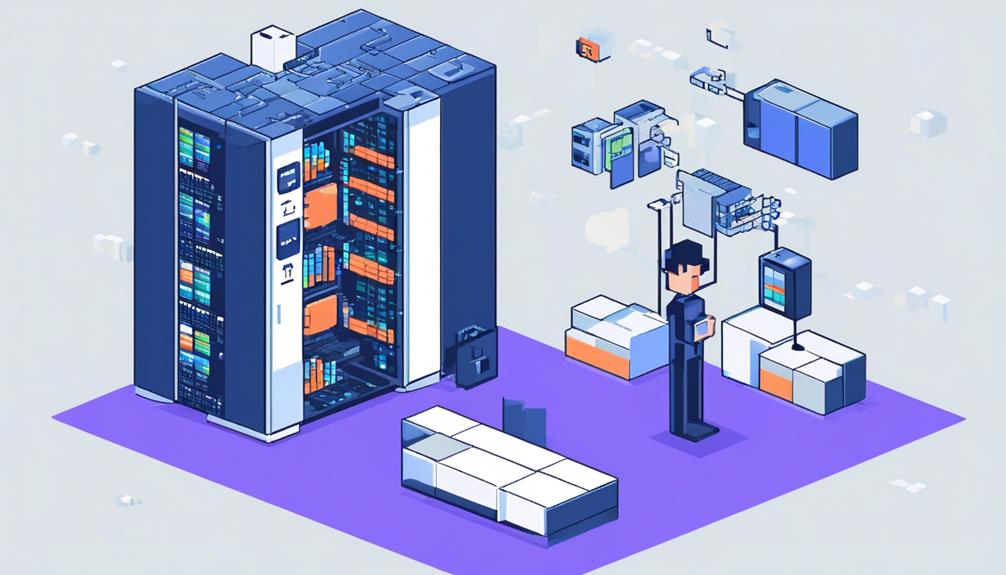Integrating PBX with business systems has become an essential strategy for organizations seeking to streamline their communication processes and enhance overall efficiency. By linking the phone system with CRM and ERP systems, companies can unlock a range of benefits.
These benefits include improved customer service, automated tasks, and valuable insights into customer interactions. However, choosing the right PBX system requires careful consideration of various factors such as communication needs, budget, scalability, deployment model, and critical features.
In this discussion, we will explore the benefits of PBX system integration, best practices for successful implementation, and the potential of integrating PBX with popular platforms like Microsoft Teams and Zapier.
So, let's delve into the world of PBX integration and discover the transformative possibilities it holds for businesses.
Key Takeaways
- Seamless integration between PBX systems and IT systems allows for a smooth flow of data and automated processes, improving efficiency and productivity.
- PBX integration with CRM systems provides access to real-time customer information, enhancing sales arguments and improving customer service.
- Integration of PBX systems facilitates streamlined communication and collaboration between teams, departments, and external stakeholders.
- Integrating PBX with business automation tools optimizes workflow processes, enhances overall customer experience, and ensures a smooth flow of information between different departments and systems.
Benefits of PBX System Integration

One of the key advantages of integrating a PBX system with business systems is the seamless flow of data between the telephone system and IT systems, achieved through automated processes. This integration allows for the exchange of information between the PBX system and other business applications, such as customer relationship management (CRM) systems. By integrating the PBX system with the CRM system, businesses can streamline their communication processes and enhance their overall efficiency.
Through CRM integration, the PBX system can automatically retrieve customer information from the CRM database when a call is received. This allows employees to have relevant customer data readily available, enabling them to provide personalized and efficient service. Additionally, the integration of the PBX system with the CRM system facilitates the creation of detailed call logs and call records, providing valuable insights into customer interactions and helping businesses improve their customer service strategies.
Furthermore, integrating the PBX system with the CRM system enables businesses to centralize their customer communication channels. This means that all customer interactions, whether through phone calls, emails, or social media, can be managed and tracked from a single platform. This streamlines ticket management, making it easier to organize and track customer calls, ensuring that no customer inquiries are overlooked or lost.
PBX-CRM Integration Benefits
PBX-CRM integration offers increased efficiency by allowing agents to access customer data from both systems, eliminating the need for platform switching.
This seamless access to customer information leads to enhanced communication and a streamlined data management process.
Increased Efficiency
Integrating PBX with business systems can significantly enhance operational efficiency by providing streamlined access to call history, recordings, and voicemails. This integration allows for improved communication and collaboration within the organization, resulting in several key benefits:
- Real-time customer information provided by the integration with CRM systems empowers sales teams with improved sales arguments and deal-closing abilities. Having access to up-to-date data enables them to tailor their pitches and address customer needs more effectively.
- Enhanced business intelligence and analytics capabilities enable sales managers to monitor and optimize employee performance. They can track call metrics, identify trends, and make data-driven decisions to improve overall sales effectiveness.
- Access to real-time calling data and previous interactions allows for personalized sales pitches and improved customer satisfaction. With this integration, sales representatives can quickly retrieve information about past conversations, ensuring a seamless customer experience.
Enhanced Communication
The integration of PBX systems with CRM software offers significant benefits in terms of enhanced communication and improved customer experience.
With this integration, agents can access customer data from both CRM and PBX systems, resulting in smoother experiences and improved conversion rates.
Real-time calling data provides valuable insights into customer interactions and streamlines workflow processes, increasing efficiency.
Integration with CRM software also improves customer service, personalization, and internal communication processes by automating tasks and enhancing productivity.
Yeastar's P-Series PBX system offers built-in integrations with top CRM platforms, providing a comprehensive suite of tools for contact centers and a better experience for all parties involved.
Streamlined Data Management
With the integration of PBX systems and CRM software, businesses can streamline data management, improving customer experiences and providing agents with seamless access to valuable customer data. This integration offers several benefits for data management:
- Agents can provide a smoother experience without switching between platforms, leading to a quick snapshot of customer needs and improving conversion rates.
- Real-time calling data for agents increases efficiency, while integration with CRM software enhances customer service and personalization.
- Improved internal communication processes and automation of tasks are achieved through PBX-CRM integration.
Improving Efficiency With PBX Integration
Integrating PBX with business systems can greatly enhance efficiency by automating workflow processes and streamlining communication.
By linking the phone system with CRM software, customer interactions can be personalized and internal communication can be automated, resulting in improved productivity.
Additionally, integrating PBX with ERP systems ensures that employee data is updated automatically and allows for easy reachability, further increasing efficiency in the organization.
Enhanced Workflow Automation
Enhanced Workflow Automation with PBX integration revolutionizes internal communication processes and maximizes operational efficiency. By integrating PBX with business systems, organizations can achieve the following:
- Streamlined Communication: PBX integration automates tasks such as call routing, call forwarding, and voicemail, eliminating manual intervention and reducing response times.
- Improved Customer Service: Integration with CRM systems provides valuable insights into customer interactions, enabling personalized service and quick issue resolution.
- Efficient Employee Management: PBX integration with ERP systems automates employee data administration, ensuring that contact information is always up-to-date and easily accessible.
With Yeastar's P-Series PBX system, built-in integrations with top CRM platforms enable single-click dialing and automatic call journaling. This enhanced workflow automation not only increases efficiency but also enhances the overall customer experience and empowers employees to work more productively.
Streamlined Communication Processes
As businesses strive for improved operational efficiency, integrating PBX systems with business processes offers a streamlined communication solution that enhances collaboration and productivity across departments and offices.
Streamlined communication processes through PBX integration aim to improve efficiency and collaboration between departments and offices. By automating workflow processes and providing valuable insights into customer interactions, PBX integration enhances customer service and personalization.
Choosing the right PBX system involves identifying specific communication needs, considering budget, scalability, critical features, and required support and maintenance.
Yeastar's P-Series PBX system offers built-in integrations with top CRM platforms, providing a comprehensive suite of tools for contact centers and valuable agent insights. PBX-CRM integration increases productivity and efficiency, improves internal communication and data management, enhances business intelligence and analytics, and boosts customer satisfaction.
Increased Productivity and Efficiency
Implementing PBX integration with business systems can significantly enhance productivity and efficiency by seamlessly integrating communication processes and providing easy access to important information.
Here are three ways in which PBX integration can improve productivity and efficiency:
- Reduction in data entry time: PBX integration can lead to a 17% reduction in time spent on data entry for salespeople. This allows them to focus more on their core tasks and increases overall productivity.
- Improved access to information: Integration provides easier access to call history, recordings, and voicemails, which is crucial for efficient communication. Having quick access to this information saves time and enables employees to provide better customer service.
- Real-time customer information: PBX-CRM integration allows for the retrieval of real-time customer information. This enhances sales arguments and improves the ability to close deals by providing up-to-date insights into customer preferences and behaviors.
PBX System Integration Best Practices
To ensure seamless integration between a PBX system and other business software applications, it is crucial to prioritize selecting a PBX system that supports API integration. Application Programming Interfaces (APIs) allow different software systems to communicate and share data, enabling businesses to streamline their operations and increase efficiency. When integrating a PBX system with other business systems, there are several best practices to consider.
Firstly, it is essential to choose a PBX system that supports scalability and growth. As businesses expand and their communication needs evolve, the PBX system should be able to accommodate the increased demand without causing disruptions. This scalability ensures that the integration remains effective in the long run.
Secondly, the selected PBX system should align with the specific communication needs and budget of the business. It is crucial to evaluate critical features like call routing, voicemail, and call recording when choosing the right PBX system. This ensures that the integration meets the business requirements and enhances overall productivity.
Thirdly, consider the required level of support and maintenance from the vendor. A reliable PBX system provider should offer ongoing technical support, regular updates, and troubleshooting assistance. This ensures that any issues that arise during the integration process can be promptly addressed, minimizing downtime and maximizing productivity.
To further illustrate these best practices, consider the following table:
| Best Practice | Description |
|---|---|
| Select a PBX system with API integration | Prioritize a PBX system that supports API integration to enable seamless communication between different software applications. |
| Ensure scalability and growth | Choose a PBX system that can accommodate future business needs and expansion without disruptions. |
| Align with communication needs and budget | Evaluate critical features and choose a PBX system that meets specific communication requirements and fits the budget. |
| Consider vendor support and maintenance | Select a PBX system provider that offers ongoing technical support, regular updates, and troubleshooting assistance. |
| Regularly review and optimize integration | Continuously monitor and optimize the PBX system integration to ensure its effectiveness and efficiency. |
Enhancing Communication With PBX Integration

Enhancing communication through PBX integration offers improved collaboration and streamlined communication processes.
By integrating the PBX system with other business software applications, companies can facilitate seamless communication between teams, departments, and even external stakeholders.
This integration allows for the sharing of real-time calling data, enabling faster decision-making and more efficient workflows.
Improved Collaboration Through PBX Integration
Improved collaboration and communication are facilitated through the integration of PBX systems with business software applications, such as CRM, resulting in increased efficiency and enhanced customer experience. Here are three ways in which PBX integration improves collaboration:
Seamless Workflow: PBX integration with CRM allows for the automatic syncing of customer data, call logs, and notes, enabling agents to have a complete view of customer interactions. This promotes a more streamlined and efficient workflow, ensuring that all team members are on the same page.
Real-time Communication: With PBX integration, agents can access real-time customer data from both the CRM and PBX systems. This enables them to provide personalized, relevant information to customers, leading to improved customer satisfaction.
Enhanced Team Collaboration: PBX-CRM integration provides managers and administrators with valuable insights and performance analytics. This allows for better resource allocation, training opportunities, and team collaboration, resulting in improved overall customer experience.
Streamlined Communication Processes
The integration of PBX systems with various business applications streamlines communication processes, promoting collaboration and efficiency across departments and offices. By integrating PBX with CRM software and other business systems, valuable insights into customer interactions can be gained, allowing for improved workflow processes.
This integration enables automated processes, seamless information flow, and enhanced functionality, ultimately improving overall business operations. PBX-CRM integration offers numerous benefits, such as improved customer experience, real-time calling data for agents, and increased productivity and efficiency for salespeople.
Yeastar's P-Series PBX system offers built-in integrations with top CRM platforms, providing features like single-click dialing, automatic call journaling, and centralized lead management. This streamlined communication process allows for more efficient and effective collaboration within the organization.
Integrating PBX With Business Automation
Integrating PBX with business automation brings numerous advantages to organizations. By seamlessly integrating PBX with IT systems, businesses can ensure a smooth flow of information between different departments and systems. This integration enhances the flexibility and functionality of the telephone system by enabling features such as automatic call logging, screen popping, and customer data retrieval.
One key benefit of integrating PBX with business automation is PBX-CRM integration. This integration allows for automated processes in corporate communication, enhancing the overall customer experience. Yeastar's P-Series PBX system offers built-in integrations with top CRM platforms, providing a comprehensive suite of tools for contact centers.
Another benefit is ERP integration. Integrating PBX with ERP systems automates employee data administration, ensuring easy reachability of employees. This integration automatically updates employee contact information in the telephone system and facilitates automated synchronization for new branch offices, making it easier to manage communication across different locations.
In addition, VirtualPBX offers Zapier Integration, allowing users to connect their VirtualPBX account to other apps like Google Sheets, Slack, Trello, and Gmail. This integration enables automated tasks and reporting, enhancing productivity and efficiency in communication processes.
Streamlining Operations With PBX Integration

Streamlining operations with PBX integration optimizes workflow processes and enhances communication efficiency by seamlessly linking the phone system with business software applications. PBX-CRM integration plays a significant role in achieving these goals. By integrating with CRM software, marketing automation tools, and other business systems, PBX systems enable businesses to improve customer service and internal communication.
The use of APIs allows for the integration of PBX systems with CRM software, enabling businesses to gain valuable insights and provide personalized service to their customers. This integration allows agents to access real-time customer data, improving the overall customer experience. With a PBX-CRM integration, agents can have a complete view of customer interactions, facilitating better decision-making and enhancing customer satisfaction.
One such example of a PBX system that offers seamless integration with CRM platforms is Yeastar's P-Series PBX. This system provides built-in integrations with leading CRM platforms, offering features like single-click dialing, automatic call journal, and live call pop-ups. These features not only enhance productivity but also streamline operations by eliminating the need for manual data entry and reducing the chances of errors.
PBX-CRM integration also improves internal communication within an organization. With a unified communication platform, employees can easily collaborate, share information, and access customer data, leading to better teamwork and increased efficiency. Additionally, the integration allows for improved data management and business intelligence, as it provides businesses with valuable insights into customer interactions and preferences.
Increasing Productivity Through PBX System Integration
By seamlessly integrating PBX systems with business software applications, companies can significantly increase productivity and optimize workflow processes. PBX integration with CRM systems, for instance, enhances customer service and personalization by providing valuable insights into customer interactions. This integration allows for easier access to call history, recordings, and real-time customer information, enabling employees to provide more efficient and tailored assistance.
The benefits of PBX-CRM integration extend beyond customer service. Internal communication processes also benefit from this integration, as it improves collaboration and information sharing among employees. With access to real-time customer data and call history, employees can communicate more effectively and make informed decisions. Additionally, streamlined ticket management ensures that customer inquiries are handled promptly and efficiently, further enhancing productivity.
Moreover, PBX integration with business software applications enables enhanced business intelligence and analytics. By combining PBX data with CRM and other business systems, companies gain valuable insights into customer behavior, call patterns, and trends. These insights can be used to make data-driven decisions, identify areas for improvement, and optimize business processes, ultimately increasing productivity.
Integration of PBX with IT systems also plays a crucial role in increasing productivity. Automated processes, seamless information flow, and enhanced flexibility and functionality of the telephone system result in streamlined operations and reduced manual effort. This integration allows for efficient call routing, call forwarding, and voicemail management, ensuring that employees can focus on their core tasks without interruptions.
PBX Integration for Better Analytics and Reporting

PBX integration facilitates enhanced analytics and reporting capabilities, providing valuable insights into customer interactions and optimizing workflow processes. By linking the phone system with other business software applications, businesses can leverage the power of integration to improve their operations.
One of the key benefits of integrating PBX with other business systems is the ability to collect and analyze real-time calling data. This data can provide a quick snapshot of customer needs and help agents increase efficiency and improve conversion rates. Through PBX-CRM integration, agents have access to customer data from both CRM and PBX systems, ensuring a smoother and more personalized interaction.
Moreover, integrating PBX with CRM systems can significantly improve the overall customer experience. It enables agents to have a comprehensive view of customer history, preferences, and interactions, allowing them to provide a more tailored and efficient service. This integration also collects important information for employee performance analytics, empowering managers to understand agent efficiency and optimize performance.
To better illustrate the benefits of PBX integration for analytics and reporting, consider the following table:
| Integration | Benefits |
|---|---|
| Benefits of PBX System Integration for Collaboration | |
| Improved communication and collaboration across teams | |
| Streamlined workflow processes | |
| Enhanced customer service | |
| Valuable customer insights | |
| Automation of tasks for increased efficiency | |
When selecting a PBX system for integration, several factors need to be considered, including communication needs, budget, scalability, deployment model, critical features, and vendor support. Yeastar's P-Series PBX system, for example, offers built-in integrations with popular CRM platforms. This integration provides features like single-click dialing, automatic call journaling, and centralized lead management, further enhancing collaboration within the organization.
PBX Integration With Microsoft Teams

Microsoft Teams integration with PBX systems revolutionizes communication and collaboration by seamlessly integrating enterprise phone system features within the Teams platform. This integration allows users to make and receive calls, access voicemail, and utilize other PBX features directly within Microsoft Teams. With PBX integration, communication becomes more streamlined and productivity is enhanced as various communication channels are consolidated into one platform.
Here are three key benefits of PBX integration with Microsoft Teams:
- Unified Communication Experience: By combining PBX functionality with the collaborative capabilities of Microsoft Teams, users can manage calls, access enterprise phone system features, and communicate with external parties all within the Teams platform. This unified communication experience eliminates the need to switch between multiple applications, saving time and improving efficiency.
- Enhanced Collaboration: PBX integration with Microsoft Teams enables seamless collaboration by providing a single platform for both messaging and voice communication. Users can initiate voice or video calls directly from a Teams chat or channel, facilitating real-time collaboration and decision-making. Additionally, the ability to access voicemail within Teams ensures that important messages are easily accessible and not missed.
- Increased Mobility and Flexibility: With PBX integration, users can access their enterprise phone system features from anywhere using the Microsoft Teams mobile app. This allows for greater mobility and flexibility, enabling users to stay connected and productive even when they are away from their desk.
PBX Integration With Zapier
Zapier integration with PBX systems facilitates seamless connectivity between the PBX phone system and a wide range of business applications. With Zapier, users can create automated workflows, known as Zaps, to connect their PBX phone system with popular business tools such as CRM platforms, email marketing software, and project management tools.
This integration allows for efficient data transfer and task automation, streamlining communication processes and enhancing productivity. By integrating their PBX system with Zapier, businesses can ensure that customer information is automatically synced between their PBX phone system and CRM platforms. This means that when a call comes in, relevant customer data is readily available to the employees, enabling them to provide personalized and efficient service.
Moreover, Zapier integration with PBX systems provides the flexibility to create custom connections and automate tasks without the need for extensive coding or technical expertise. Businesses can set up Zaps to automatically create new leads in their CRM platform when a call is received, send email notifications to specific team members when a voicemail is left, or create tasks in their project management tool when a call is missed.
PBX Data Storage With AWS Integration

The integration of PBX systems with Amazon Web Services (AWS) enables businesses to securely and reliably store call recordings, faxes, and voicemails for long-term data management. This integration provides complete control over call data and takes advantage of the industry-leading reliability of AWS for seamless data storage.
Here is a breakdown of how PBX data storage with AWS integration works:
- AWS Cloud Storage: By leveraging the power of AWS, businesses can store their call recordings, faxes, and voicemails in the cloud. AWS offers a highly secure and scalable storage solution that ensures data is protected and accessible at any time.
- API Access and Webhooks: With API access and webhooks, businesses can create customized solutions and direct integrations with their existing business tools. This allows for seamless workflows and applications tailored to specific business needs, such as integrating call data with CRM systems for enhanced customer management.
- Flexibility and Scalability: The integration of PBX systems with AWS provides businesses with the flexibility to create unique integrations, applications, and workflows for improved efficiency and data management. Whether it's creating automated processes or analyzing call data for insights, businesses can scale their storage and access capabilities as needed.
PBX Integration With API and Webhooks
With the seamless integration of PBX systems and API access, businesses can unlock customized solutions and streamlined workflows for enhanced data management and business efficiency.
API access allows businesses to integrate their PBX systems with various applications, such as CRM software, enabling valuable insights and automated tasks. By leveraging APIs, businesses can centralize their data and gain a comprehensive view of their customers and operations.
Webhooks provide another method for PBX integration with business tools. Webhooks enable direct integrations with platforms like Zapier, allowing for seamless data exchange and streamlined workflows.
For example, VirtualPBX offers Zapier Integration, enabling connections with popular apps like Google Sheets, Slack, Trello, and Gmail. This integration allows businesses to automate tasks, such as updating spreadsheets, sending notifications, and managing email communications, resulting in increased productivity and efficiency.
To facilitate PBX integration with APIs and webhooks, businesses can refer to API documentation provided by their PBX service provider. API documentation offers valuable resources and guidelines for businesses to understand and implement API integrations for their unique needs. It provides detailed information about API endpoints, data formats, authentication methods, and available functionalities.
Frequently Asked Questions
What Is PBX Integration?
PBX integration refers to the process of linking a phone system with other business software applications. It involves leveraging communication technology to connect the PBX system with customer relationship management (CRM) software. This integration enables organizations to gain valuable insights into customer interactions and streamline workflow processes. By integrating PBX with CRM, businesses can enhance customer service, personalize interactions, improve internal communication, automate tasks, and access real-time calling data.
Yeastar's P-Series PBX system offers built-in integrations with leading CRM platforms. These integrations provide features like single-click dialing and automatic call journaling.
What Is a PBX Systems for Small Business?
A PBX system for small businesses is a telephony solution that manages incoming and outgoing calls within the organization. It offers features like call routing, voicemail, and call forwarding, improving communication efficiency.
PBX systems can be traditional or cloud-based, with the latter option being more cost-effective for startups. By integrating a PBX system with other business software applications, small businesses can gain valuable insights into customer interactions and streamline workflow processes.
Choosing the right PBX system involves considering specific communication needs, scalability, and critical features.
Is PBX Obsolete?
PBX systems have evolved significantly over the years, rendering the notion of obsolescence inaccurate. While traditional PBX systems may be less prevalent due to the rise of cloud-based solutions, PBX technology continues to thrive with advanced features and integration capabilities.
Today's PBX systems offer enhanced communication and collaboration tools, enabling businesses to streamline operations and improve customer service. Therefore, it is crucial to consider the evolving landscape of PBX systems when evaluating their relevance and potential integration with business systems.
How Do I Connect to Pbx?
To connect to a PBX system, you need to follow a series of steps to ensure a successful connection.
First, determine the specific communication needs of your business and select a suitable PBX system.
Then, configure the PBX settings, including network connectivity and user extensions.
Finally, test the connection and troubleshoot any issues that may arise, such as call quality or connectivity problems.
